Help Desk Strategy: Features, Benefits and Methods
A well-crafted help desk strategy serves as the North Star that guides businesses through the maze of customer inquiries, ensuring swift resolutions, satisfied customers, and a stellar reputation.
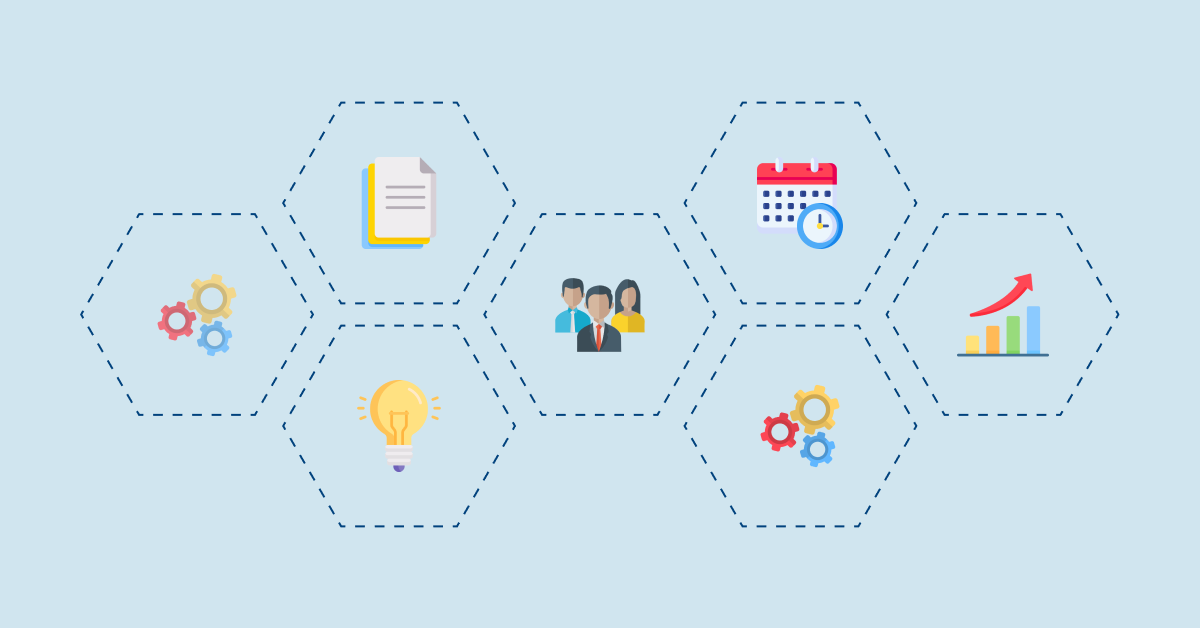
A well-crafted help desk strategy serves as the North Star that guides businesses through the maze of customer inquiries, ensuring swift resolutions, satisfied customers, and a stellar reputation.

Providing excellent customer service has always been key for all businesses to become successful. A help desk plays a vital role in achieving the crucial goal. Lacking a proper service desk strategy can cause challenges and gaps, making it difficult to provide top-notch customer service.
More than 90% of customers say good service makes them more likely to buy again. That’s not a vague stat, it’s a clear reminder that support isn’t just a backend function, it’s a dealbreaker. A solid help desk strategy isn’t optional; it’s how you fix problems fast, keep customers happy, and build actual trust. Let’s break down what makes a help desk work by looking at the tools you need, the methods that matter and how to handle support in a way that actually helps.
Let us learn more about them with the help of a comprehensive help desk guide so you can provide remarkable customer support.
A help desk strategy can be defined as a comprehensive plan that outlines how an organization’s technical support team will deliver assistance, resolve issues and manage customer service interactions. It serves as a roadmap for handling user requests, maintaining service quality and achieving operational excellence in IT support.
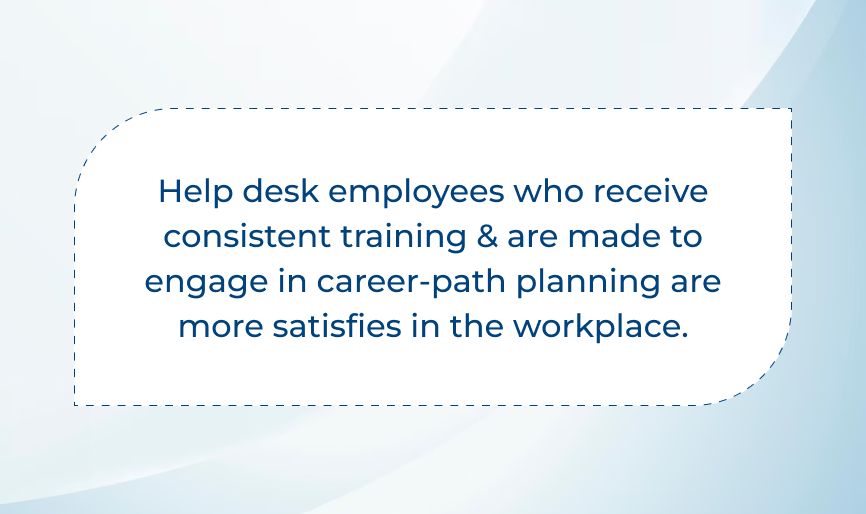
The importance of a well-defined help desk strategy cannot be overstated. It ensures consistent service delivery, reduces response times and improves customer satisfaction. A robust strategy helps organizations optimize resource allocation, standardize support processes and maintain high service levels while controlling costs.
Key objectives:
A solid support desk solves problems quickly and without hassle. When it works, customers leave satisfied and don’t come back with the same issue. Here are six essentials that make that happen.

A successful help desk strategy must have clear objectives and goals that align with the organization’s overall business goals. These goals provide a clear direction and purpose for the help desk team, driving their efforts toward delivering exceptional customer support. Companies can implement strategies and practices that directly contribute to achieving these objectives by prioritizing customer satisfaction.
Let’s say the help desk aims to reduce response time to customer inquiries, increase first-call resolution rates, or enhance the overall customer experience. Setting specific and measurable goals gives the help desk team clarity.
A robust ticket management system is essential for effectively tracking and managing customer issues. An efficient help desk workflow encompasses features such as automated ticket routing, escalation protocols, and reporting capabilities.
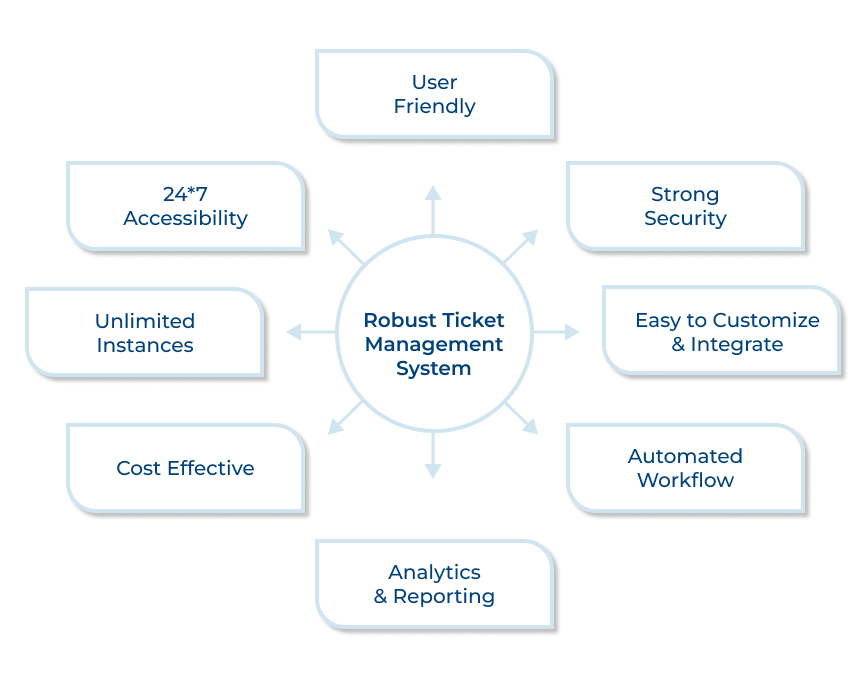
Automating ticket routing ensures that incoming inquiries are directed to the most appropriate agent or team, resulting in faster response time and efficient issue resolution. Escalation protocols enable the seamless transfer of complex or unresolved cases to senior personnel, preventing bottlenecks and ensuring timely resolution.
Efficient communication channels are essential for addressing customer inquiries promptly and conveniently. A help desk strategy should provide multiple communication channels such as email, chat, phone, and social media platforms. Each channel should be readily available and actively monitored to ensure timely responses.
Customers can choose the most convenient method of contacting support. It enhances accessibility and customer satisfaction by accommodating their preferred communication channels. Active monitoring ensures no inquiry goes unnoticed, enabling proactive assistance and swift resolution, regardless of the chosen communication channel.
A comprehensive knowledge base is crucial for equipping help desk personnel with the information they need to assist customers effectively. Integrating a knowledge base with your IT asset management system ensures agents have instant access to up-to-date asset data, product details, and troubleshooting steps. The knowledge base should be easily accessible and regularly updated to cover any changes or updates.
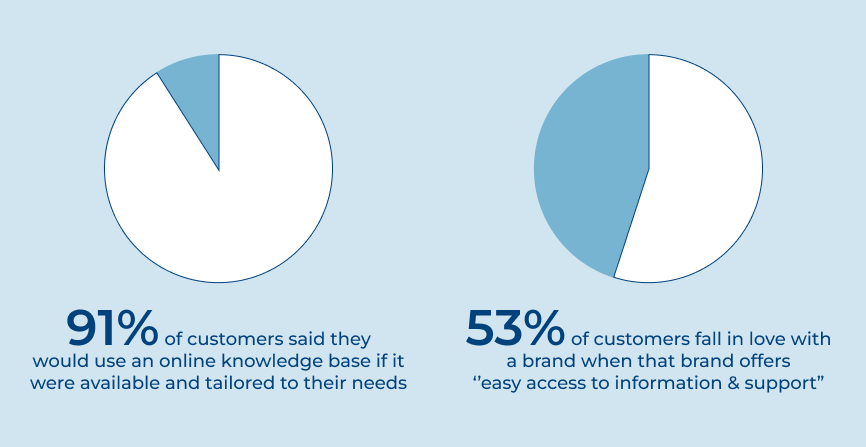
The knowledge base enables help desk agents to quickly find solutions, answer queries, and provide accurate guidance to customers. It results in faster resolution times, improved customer satisfaction, and consistent support across the team. Regularly updating the knowledge base ensures that agents have access to the latest information, empowering them to deliver up-to-date and reliable assistance to customers.
An effective help desk strategy requires a well-trained and proficient team of support personnel. Help desk agents should possess excellent communication skills, empathy, and technical expertise to effectively handle customer inquiries.
Regular training programs should be conducted to keep the team updated on new products, services, and emerging trends. Help desk personnel can deliver high-quality support, build customer trust, and promote long-lasting relationships.
Continuous improvement is vital for enhancing the effectiveness of a help desk strategy. Regularly gathering customer feedback provides valuable insights into the strengths and areas needing improvement within the support system.
Analyzing the feedback helps identify opportunities for process optimization, training enhancements, and technology upgrades. The help desk strategy can evolve and adapt to better meet customer needs by implementing the necessary improvements based on customer feedback.
Having well-defined escalation procedures is crucial for a successful help desk strategy. These procedures outline the steps and criteria for escalating customer issues to higher levels of support or management. The help desk team can ensure that complex or unresolved issues receive the required attention by establishing a clear escalation path.
Effective escalation procedures provide several benefits, including timely resolution of critical issues, efficient allocation of resources, and improved customer satisfaction. They enable the help desk team to collaborate seamlessly with other teams or departments, facilitating the swift resolution of issues and preventing customer frustration.
Surveys are valuable tools for gathering feedback on the quality of support provided by the help desk. The average business hears from 4% of its dissatisfied customers. These surveys also help you understand how satisfied your customers are.
The implementation of the implementing customer satisfaction surveys enables businesses to gain insights into customer perceptions. Customer satisfaction surveys provide actionable insights that can be used to identify training needs, optimize support processes, and improve overall service delivery.
Let us go through the benefits of using a modern help desk system in your business and how it can propel you toward greater success.
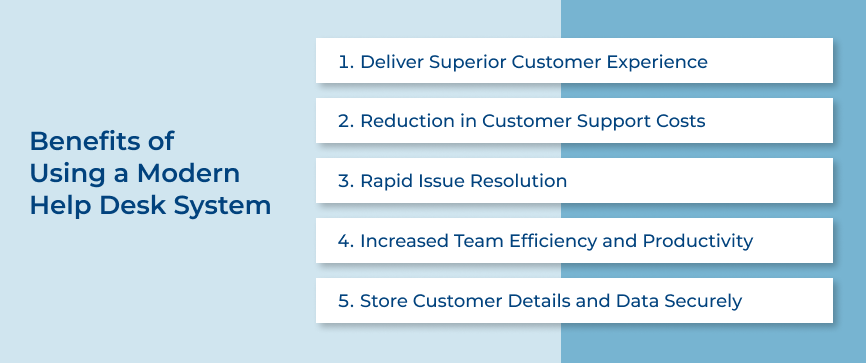
Deliver Superior Customer Experience
One main help desk strategy benefit is providing remarkable customer support. As per PWC, 86% of buyers are willing to pay more for a great customer experience. A help desk system is designed to deliver a personalized customer experience across multiple channels such as email, chat, phone, and social media. With features like ticket tracking, automated routing, and intelligent self-service portals, businesses can deliver an exceptional customer experience with a personal touch.
Reduction in Customer Support Costs
A modern help desk system offers businesses the opportunity to significantly reduce customer support costs by leveraging automation, streamlining workflows, and improving agent productivity. Automating repetitive tasks enables businesses to eliminate the need for manual intervention, saving valuable time and resources.
Rapid Issue Resolution
Features like automated ticket prioritization and escalation enable businesses to resolve critical issues in a timely manner, thereby reducing customer churn. Customer retention is one of the top priorities of businesses today. And why wouldn’t it be? Increasing customer retention rates by just 5% can increase profits between 25% and 95%.
Increased Team Efficiency and Productivity
Companies can optimize their support processes by automating repetitive tasks, improving agent performance, and providing real-time analytics. It can help businesses increase team productivity, leading to faster issue resolution, higher customer satisfaction, and improved bottom-line performance.
Store Customer Details and Data Securely
A modern help desk system allows businesses to securely store customer details and data in the cloud, reducing the risk of data loss or breach. The inclusion of advanced security features like data encryption, multi-factor authentication, and role-based access control actively safeguards customer data.
The following are the help desk strategies that will pave the way for a seamless rollout, enhancing efficiency and satisfaction across the board. Get ready to transform your help desk experience from chaotic to cohesive!

A comprehensive support desk strategy should ensure customers can access support through an omnichannel approach. Make sure to have various point of contact options, including phone, email, and live chat, through which the customers can reach out.
The omnichannel approach should focus on providing timely customer service and detailed solutions to problems to meet customer expectations effectively Businesses can provide customer service that is both efficient and effective by implementing a well-developed help desk strategy with an omnichannel approach.
Actionable Tips:
Customers should always have access to knowledge-based self-service options through an effective help desk strategy. Customers can now control their customer service experience, eliminating the need to wait for assistance and empowering them to seek help independently.
A study on online consumers from the UK, USA, Australia, France, Germany, and Italy revealed that more than 51% of customers prefer technical support through a knowledge base. Companies can actively reduce customer wait times and enhance the overall customer experience.
Actionable Tips:
A Service Level Agreement (SLA) should be established to ensure a successful support desk strategy. The strategy should clearly define the expected level of service customers can rely on when seeking assistance. It ensures transparency, sets expectations, and delivers satisfactory support experiences.
Having an SLA helps ensure customer inquiries are handled professionally and promptly, ensuring high customer satisfaction. The SLAs should always be focused on meeting the customer’s needs.
Actionable Tips:
Provide automated support to reduce customer wait times and relieve customer service representatives of their workload. By automating specific aspects of the customer service process, companies can provide prompt customer responses, eliminating the need for prolonged waiting periods.
No wonder the help desk strategy is becoming increasingly popular in businesses as it balances automation and human connection. It ensures customers resolve their issues quickly and efficiently without sacrificing personalized attention.
Actionable Tips:
An effective help desk strategy should prioritize delivering real-time assistance to customers, promptly addressing and resolving their issues for optimal satisfaction. As the other benefits above, it can help reduce response time, increase customer satisfaction, and minimize the cost of managing customer inquiries.
Offering prompt responses and solutions to customer queries allows help desks to ensure customers receive the best experience possible.
Actionable Tips:
Selecting the most suitable help desk tool for the business can be challenging as there are multiple options out there. A carefully chosen help desk tool should streamline processes, offer customer support effectively and provide valuable insights into customer interactions.
A reliable tool will enable you to identify the room for improvement and provide better customer service. It will also enhance productivity, efficiency, and customer satisfaction.
Actionable Tips:
An efficacious support desk strategy requires training your support staff to become knowledgeable subject matter experts. It allows them to provide customers with accurate information and solutions on time. Customer satisfaction and brand recognition are enhanced.
When support teams truly understand their work instead of just following scripts, they solve problems faster and more accurately. Customers notice. It builds trust because the help actually works, not because of flashy promises.
Actionable Tips:
Crafting a successful service desk strategy begins with understanding and measuring key help desk metrics to identify areas for continuous improvement. Measuring customer satisfaction, first contact resolution rate, call volume and response time, or other key metrics can provide valuable insights into the effectiveness of the help desk processes.
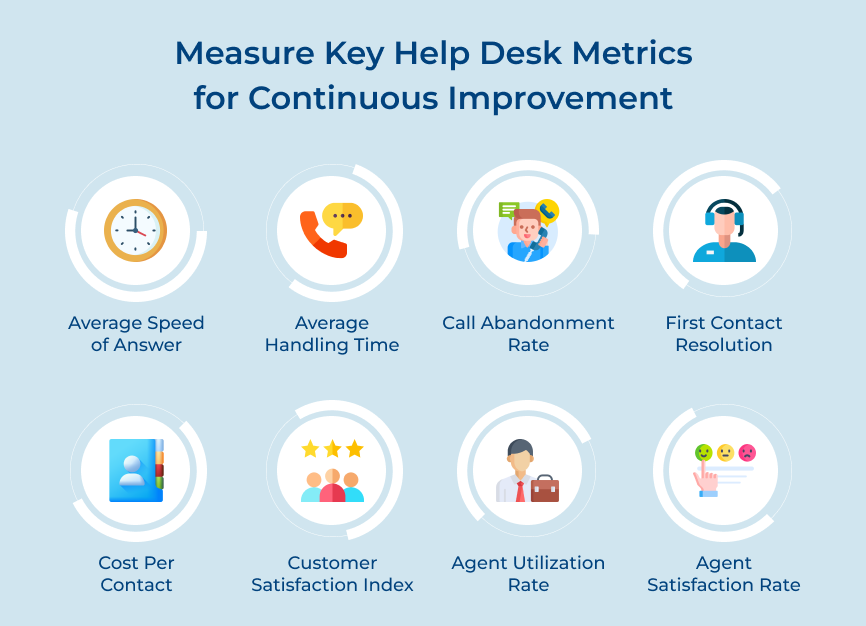
The data can be used to develop strategies that drive improved customer service. Businesses can also easily optimize their efficiency and reduce their expenditure by analyzing the data.
Actionable Tips:
A well-defined help desk strategy is essential for an organization to achieve its goals and facilitate seamless collaboration. Internal processes should be established to clarify how to handle inquiries, prioritize tasks, and allocate resources.
Companies should periodically update these processes to align with their changing needs and adapt to the ever-evolving technologies. It will ensure that the organization can continuously benefit from improved quality, increased cost savings and optimized results.
Actionable Tips:
A help desk strategy works best when support teams pay close attention to what customers are saying and take action. Ignoring complaints or brushing off suggestions weakens the entire system. But when teams respond to real concerns, they not only solve issues more effectively but also show customers they’re being heard.
Customer feedback is also one of the clearest ways to spot what’s not working behind the scenes. It highlights broken processes, recurring issues, and areas where the system slows down. Acting on that information leads to a more efficient help desk, where fewer things fall through the cracks and teams can focus on solving problems instead of chasing them.
Actionable Tips:
Here are the key metrics that help organizations evaluate and optimize their help desk performance. These measurements will help you understand your service quality, efficiency and customer satisfaction levels.
1. First Contact Resolution (FCR) Rate
The metric measures the percentage of support tickets resolved during the first interaction, without escalation or follow-up. High FCR rates indicate efficient problem-solving capabilities and well-trained staff. Industry standards suggest aiming for an FCR rate of 70-75%.
2. Average Response Time
Measures how fast the help desk team picks up new tickets and starts working on them. It looks at response times across channels and then considers the ticket priority. The goal is simple: respond quickly so issues don’t pile up or get worse.
3. Customer Satisfaction Score (CSAT)
Gathered through post-interaction surveys, CSAT measures user satisfaction with the support received. It typically includes ratings for technician knowledge, professionalism and overall experience. Regular monitoring helps identify areas for improvement and training needs.
4. Average Resolution Time
ART measures the average time taken to completely resolve an issue from ticket creation to closure. The metric helps identify bottlenecks in the support process and areas where additional resources or training may be needed.
5. Ticket Volume and Distribution
Analyzes the number of tickets received across different categories, priorities, and time periods. The data helps in resource planning, identifying common issues and understanding peak support times. It’s crucial for staffing decisions and process optimization.
Many businesses struggle to keep up with customer service inquiries, leading to longer response times and lost customers. Maintaining exceptional customer service demands substantial effort and resource allocation, making it necessary for most businesses. As the competition intensifies, delivering exceptional customer service becomes vital in maintaining a competitive edge.
Without a help desk strategy, your business will be left behind as customers flock to competitors who offer better customer service. So get a powerful strategy that suits your business in place and maximize the potential of your help desk.
The best approach to help desk support is one that is tailored to your business needs and your customers’ preferences. It includes choosing the right help desk system, training your team to handle customer inquiries effectively and providing support across multiple channels. Consider going through a few help desk strategy examples or templates for a better understanding.
A help desk process is a set of activities & procedures that guide handling customer inquiries and support requests. Organizations receive, categorize, prioritize, and resolve customer issues through multiple channels. Make sure to go through the help desk strategy templates and help desk strategy examples to understand the process better.
Prioritize delivering a superior customer experience, reducing support costs, and boosting team productivity. You can do it all by choosing the right help desk system, training your team effectively, and monitoring your performance regularly to optimize your approach. Help desk strategy best practices will also help in understanding how to implement the help desk for better performance.
Companies need a help desk strategy to deliver efficient and consistent customer support. A help desk streamlines customer inquiries, ensuring timely responses and issue resolution. It enhances customer satisfaction by providing personalized and empathetic interactions. A well-organized help desk also increases the efficiency of support teams, allowing them to handle a higher volume of queries effectively. It offers valuable insights into customer preferences and pain points for continuous improvement.
Start by building a skilled and knowledgeable support team. Provide comprehensive training on products, services, and customer service best practices. Implement a ticketing system to efficiently manage and track customer inquiries. Offer multi-channel support to accommodate diverse customer preferences. Regularly update and optimize the knowledge base to provide self-service options. Proactively communicate with customers and seek their feedback to address their needs effectively.
An effective help desk strategy can be adapted to changing customer needs by continuously monitoring customer feedback and analyzing performance metrics. Stay updated with industry trends and emerging technologies. Implement AI-powered chatbots or virtual assistants for instant responses. Regularly review and update support processes to ensure they align with customers’ evolving preferences/expectations.
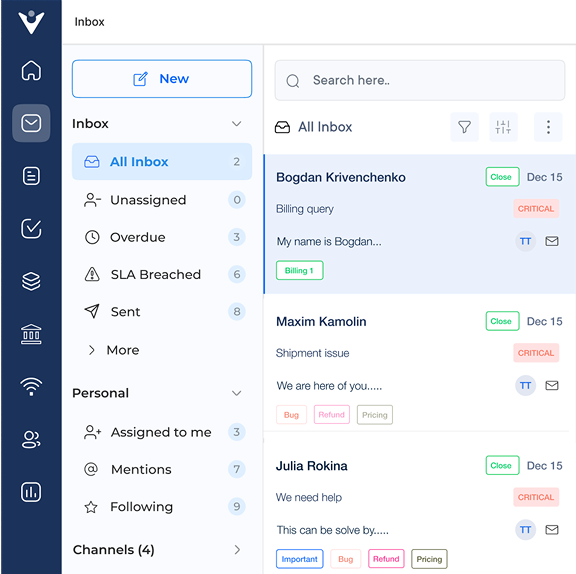
Market better, sell faster and support smarter with Veemo’s Conversation Customer Engagement suite of products.
Unify all your customer data in one platform to deliver contextual responses. Get a 360 degree view of the customer lifecycle without switching tools.
Connect with the tools you love to reduce manual activities and sync your business workflows for a seamless experience.
 https://veemo.io/wp-content/uploads/2024/12/customer-service-response-time.png
1256
2400
indrasish5342@gmail.com
https://veemo.io/wp-content/uploads/2024/11/veemo.svg
indrasish5342@gmail.com2025-10-17 10:51:142025-12-15 05:49:239 Effective Tips to Reduce Customer Service Response Time
https://veemo.io/wp-content/uploads/2024/12/customer-service-response-time.png
1256
2400
indrasish5342@gmail.com
https://veemo.io/wp-content/uploads/2024/11/veemo.svg
indrasish5342@gmail.com2025-10-17 10:51:142025-12-15 05:49:239 Effective Tips to Reduce Customer Service Response Time https://veemo.io/wp-content/uploads/2024/10/How-to-Create-Knowledge-Base.png
1257
2400
Vikas Sachan
https://veemo.io/wp-content/uploads/2024/11/veemo.svg
Vikas Sachan2024-10-21 12:24:342025-12-15 05:58:17How to Create a Knowledge Base in 9 Easy Steps: The Ultimate Guide
https://veemo.io/wp-content/uploads/2024/10/How-to-Create-Knowledge-Base.png
1257
2400
Vikas Sachan
https://veemo.io/wp-content/uploads/2024/11/veemo.svg
Vikas Sachan2024-10-21 12:24:342025-12-15 05:58:17How to Create a Knowledge Base in 9 Easy Steps: The Ultimate Guide https://veemo.io/wp-content/uploads/2024/02/Live-Chat-for-Sales.png
628
1200
Vikas Sachan
https://veemo.io/wp-content/uploads/2024/11/veemo.svg
Vikas Sachan2024-10-21 11:31:222025-12-15 05:58:19How to Use Live Chat for Sales? 7 Proven Ways to Grow Revenue
https://veemo.io/wp-content/uploads/2024/02/Live-Chat-for-Sales.png
628
1200
Vikas Sachan
https://veemo.io/wp-content/uploads/2024/11/veemo.svg
Vikas Sachan2024-10-21 11:31:222025-12-15 05:58:19How to Use Live Chat for Sales? 7 Proven Ways to Grow RevenueGrow Customer Relationships and stronger team collaboration with our range of products across the Conversational Engagement Suite.

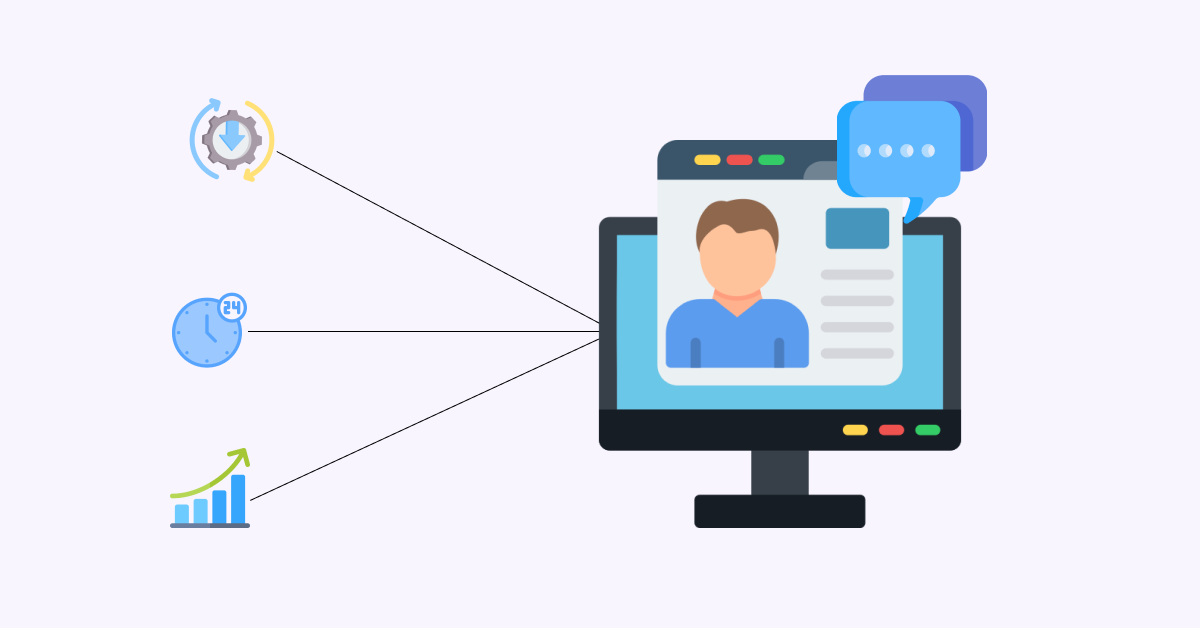 Customer Service Operations: The Ultimate Guide
Scroll to top
Customer Service Operations: The Ultimate Guide
Scroll to top